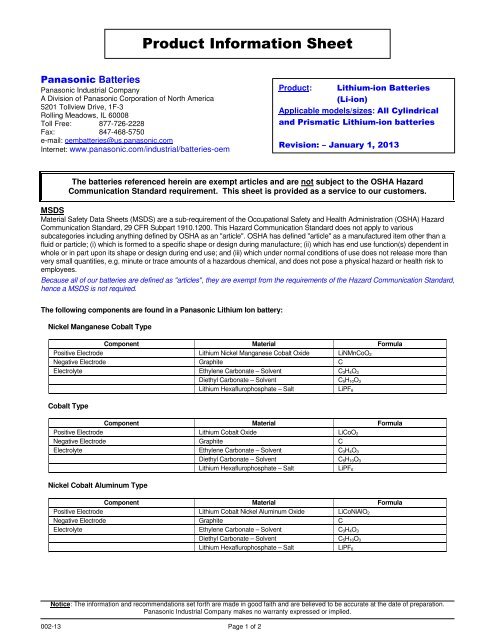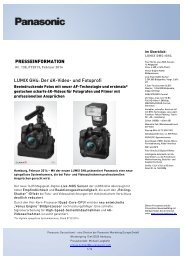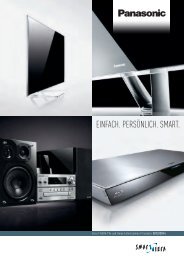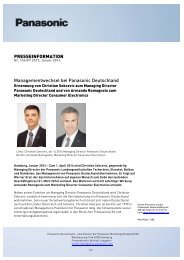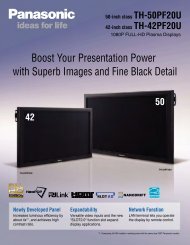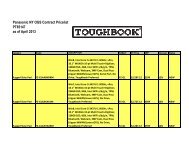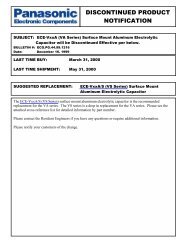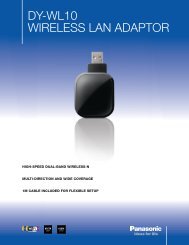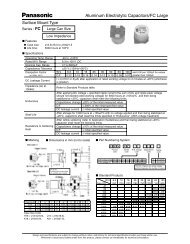Lithium Ion Product Information Sheet - Inspired Energy
Lithium Ion Product Information Sheet - Inspired Energy
Lithium Ion Product Information Sheet - Inspired Energy
Create successful ePaper yourself
Turn your PDF publications into a flip-book with our unique Google optimized e-Paper software.
<strong>Product</strong> <strong>Information</strong> <strong>Sheet</strong><br />
Panasonic Batteries<br />
Panasonic Industrial Company<br />
A Division of Panasonic Corporation of North America<br />
5201 Tollview Drive, 1F-3<br />
Rolling Meadows, IL 60008<br />
Toll Free: 877-726-2228<br />
Fax: 847-468-5750<br />
e-mail: oembatteries@us.panasonic.com<br />
Internet: www.panasonic.com/industrial/batteries-oem<br />
<strong>Product</strong>: <strong>Lithium</strong>-ion Batteries<br />
(Li-ion)<br />
Applicable models/sizes: All Cylindrical<br />
and Prismatic <strong>Lithium</strong>-ion batteries<br />
Revision: – January 1, 2013<br />
The batteries referenced herein are exempt articles and are not subject to the OSHA Hazard<br />
Communication Standard requirement. This sheet is provided as a service to our customers.<br />
MSDS<br />
Material Safety Data <strong>Sheet</strong>s (MSDS) are a sub-requirement of the Occupational Safety and Health Administration (OSHA) Hazard<br />
Communication Standard, 29 CFR Subpart 1910.1200. This Hazard Communication Standard does not apply to various<br />
subcategories including anything defined by OSHA as an "article". OSHA has defined "article" as a manufactured item other than a<br />
fluid or particle; (i) which is formed to a specific shape or design during manufacture; (ii) which has end use function(s) dependent in<br />
whole or in part upon its shape or design during end use; and (iii) which under normal conditions of use does not release more than<br />
very small quantities, e.g. minute or trace amounts of a hazardous chemical, and does not pose a physical hazard or health risk to<br />
employees.<br />
Because all of our batteries are defined as "articles", they are exempt from the requirements of the Hazard Communication Standard,<br />
hence a MSDS is not required.<br />
The following components are found in a Panasonic <strong>Lithium</strong> <strong>Ion</strong> battery:<br />
Nickel Manganese Cobalt Type<br />
Component Material Formula<br />
Positive Electrode <strong>Lithium</strong> Nickel Manganese Cobalt Oxide LiNMnCoO 2<br />
Negative Electrode Graphite C<br />
Electrolyte Ethylene Carbonate – Solvent C 3H 4O 3<br />
Diethyl Carbonate – Solvent C 5H 10O 3<br />
<strong>Lithium</strong> Hexaflurophosphate – Salt LiPF 6<br />
Cobalt Type<br />
Component Material Formula<br />
Positive Electrode <strong>Lithium</strong> Cobalt Oxide LiCoO 2<br />
Negative Electrode Graphite C<br />
Electrolyte Ethylene Carbonate – Solvent C 3H 4O 3<br />
Diethyl Carbonate – Solvent C 5H 10O 3<br />
<strong>Lithium</strong> Hexaflurophosphate – Salt LiPF 6<br />
Nickel Cobalt Aluminum Type<br />
Component Material Formula<br />
Positive Electrode <strong>Lithium</strong> Cobalt Nickel Aluminum Oxide LiCoNiAlO 2<br />
Negative Electrode Graphite C<br />
Electrolyte Ethylene Carbonate – Solvent C 3H 4O 3<br />
Diethyl Carbonate – Solvent C 5H 10O 3<br />
<strong>Lithium</strong> Hexaflurophosphate – Salt LiPF 6<br />
Notice: The information and recommendations set forth are made in good faith and are believed to be accurate at the date of preparation.<br />
Panasonic Industrial Company makes no warranty expressed or implied.<br />
002-13 Page 1 of 2
DISPOSAL<br />
All Panasonic <strong>Lithium</strong> ion batteries are classified by the federal government as non-hazardous waste and<br />
are safe for disposal in the normal municipal waste stream. These batteries, however, do contain recyclable<br />
materials. Panasonic is a Licensee of the Call2Recycle Battery Recycling Program. If you build our cells into a<br />
battery pack, please call 1-800-8-BATTERY or go to the Call2Recycle website at www.call2recycle.org for<br />
additional information on how your branded product can also participate in the program.<br />
TRANSPORTATION<br />
All Panasonic lithium ion batteries are not subject to the other requirements of the US Department of Transportation (DOT)<br />
Subchapter C, Hazardous Materials Regulations if shipped in compliance with 49 CFR 173.185 and Special Provision 188.<br />
Effective January 1, 2013 all Panasonic lithium ion batteries can be shipped by air in accordance with International Civil Aviation<br />
Organization (ICAO) 2013-2014 edition, Section II or Section 1B or International Air Transport Association (IATA), 54th edition,<br />
Section II or 1B, Packing Instructions (PI) 965 (Batteries), PI 966 (Batteries, packed with equipment) and PI 967 (Batteries,<br />
contained in equipment) as appropriate.<br />
Currently all Panasonic lithium ion batteries are regulated by the International Maritime Organization (IMO), 2010 edition, 35 th<br />
amendment, under Special Provisions 188 and 230.<br />
All Panasonic lithium ion cells are tested and comply with the UN Model Regulations, Manual of Test and Criteria, Part III,<br />
subsection 38.3.<br />
If you build any of our lithium ion cells into a battery pack, you must also assure that they are tested in accordance with the UN<br />
Model Regulations, Manual of Test and Criteria. Part III, subsection 38.3, 5 th revised edition, Amendment 1.<br />
If you plan on transporting any untested prototype battery packs contact your Panasonic Sales Representative for regulatory<br />
information.<br />
FIRST AID<br />
If you get electrolyte in your eyes, flush with water for 15 minutes without rubbing and immediately contact a physician.<br />
If you get electrolyte on your skin wash the area immediately with soap and water. If irritation continues, contact a<br />
physician. If the battery is ingested, call the National Capital Poison Center (NCPC) at 202-625-3333 (Collect) or your<br />
local poison center immediately.<br />
GENERAL RECOMMENDATIONS<br />
CAUTION: Risk of fire, explosion and burns. Do not short-circuit, crush, incinerate or disassemble battery.<br />
FIRE SAFETY<br />
In case of fire, you can use dry chemical, alcohol resistant foam or carbon dioxide fire extinguishers. Cooling the<br />
exterior of the batteries will help prevent rupturing. Burning of these batteries will generate toxic fumes. Fire fighters<br />
should use self-contained breathing apparatus. Detailed information on fighting a lithium ion battery fire can be found in<br />
Guide 147 (<strong>Lithium</strong> <strong>Ion</strong> Batteries) of the US DOT Emergency Response Guide.<br />
Notice: The information and recommendations set forth are made in good faith and are believed to be accurate at the date of preparation.<br />
Panasonic Industrial Company makes no warranty expressed or implied.<br />
002-13 Page 2 of 2


